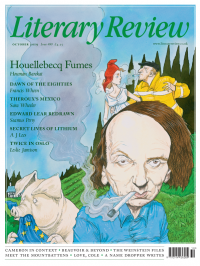Robin Simon
The Eyes Have It
Postures: Body Language in Art
By Desmond Morris
Thames & Hudson 319pp £24.95
I was preparing a series of lectures about the relationship between acting and painting and was feeling pretty pleased with myself. I had realised that, when writing Henry V’s exhortation to his army before Harfleur, Shakespeare drew upon traditional ideas about the depiction of the ‘passions’. Henry tells his men: ‘Disguise fair nature with hard-favour’d rage;/Then lend the eye a terrible aspect;/Let it pry through the portage of the head/Like the brass cannon … /Now set the teeth and stretch the nostril wide.’ These precise instructions would enable the soldiers to simulate rage in the manner described in treatises setting out the physical manifestation of emotions, reaching back at least to Quintilian in the first century AD. Shakespeare could have read all about this in Richard Haydocke’s translation of Lomazzo’s Trattato, which appeared in 1598, the year before Henry V was first performed. Lomazzo says that rage is an emotion between anger and fury. It makes you shake, ‘set your teeth’, ‘clench the hands’ and ‘look horribly out from above’. Neat, I thought (and Quintilian’s description was an even closer match). And then I read Samuel Foote’s Treatise on the Passions, written in 1747. He chose to begin his discussion with rage, and then asked:
Why do I tire the Public with my trifling Observations on this Passion, when the immortal Shakespear, has so finely described the Effects of Rage, in Harry the Vth that Monarch before an Engagement … and advises them to imitate the Action of the Tyger, stiffen the Sinews, summon up the blood, to lend the Eye a terrible Aspect.
I felt a bit deflated. Mine was not a new discovery, then – but at least I was on the right track. By Foote’s time, actors and painters alike would invariably consult authorities on the passions. The acknowledged supremo was Charles Le Brun, whose illustrated Conférence sur l’expression

Sign Up to our newsletter
Receive free articles, highlights from the archive, news, details of prizes, and much more.@Lit_Review
Follow Literary Review on Twitter
Twitter Feed
Few writers have been so eagerly mythologised as Katherine Mansfield. The short, brilliant life, the doomed love affairs, the sickly genius have together blurred the woman behind the work.
Sophie Oliver looks to Mansfield's stories for answers.
Sophie Oliver - Restless Soul
Sophie Oliver: Restless Soul - Katherine Mansfield: A Hidden Life by Gerri Kimber
literaryreview.co.uk
Literary Review is seeking an editorial intern.
Though Jean-Michel Basquiat was a sensation in his lifetime, it was thirty years after his death that one of his pieces fetched a record price of $110.5 million.
Stephen Smith explores the artist's starry afterlife.
Stephen Smith - Paint Fast, Die Young
Stephen Smith: Paint Fast, Die Young - Jean-Michel Basquiat: The Making of an Icon by Doug Woodham
literaryreview.co.uk